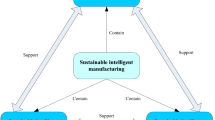Abstract
A full-featured digital representation of all the characteristics of a physical system or object is known as a Digital Twin (DT) and smart manufacturing is made possible in large part by our relationship to the environment. A DT system is simulated in real time and with high accuracy. While, maintaining constant synchronization provides a comprehensive system with physical system management. The use of a DT for a 3D printer is covered in this article which presents the 3D printer’s settings and relevant warnings in real time and uses a lightweight Augmented Reality (AR) model to let users control the basic printer functions that encourage communication between two parties. The tri-model simulates actual physical behavior while operating simultaneously and digital model features. To verify the architecture and method that have been proposed, further investigation is done using a case study of a DT facility using open-source 3D printing. Additionally, future research and conclusions are highlighted to offer illuminating information finally to the two industries and the academic world. We have an economical DT ecosystem, robust and reproducible, thereby allowing the addition of DT capabilities to legacy equipment; creating analytics using historical data that have been collected.










Similar content being viewed by others
Data availability
Not applicable.
References
Kantaros A, Piromalis D, Tsaramirsis G, Papageorgas P, Tamimi H. 3D printing and implementation of DTs: current trends and limitations. Appl Syst Innov. 2021;5(1):7.
Piromalis D, Kantaros A. DTs in the automotive industry: the road toward physical-digital convergence. Appl Syst Innov. 2022;5(4):65.
Corradini F, Silvestri M. Design and testing of a DT for monitoring and quality assessment of the material extrusion process. Addit Manuf. 2022;51: 102633.
Garikapati P, Balamurugan K, Latchoumi TP, Malkapuram R. A cluster-profile comparative study on machining AlSi 7/63% of SiC hybrid composite using agglomerative hierarchical clustering and K-means. SILICON. 2021;13:961–72.
Weinand S, Rosenberger P. Digital-twin-software areas of application, chances, and challenges. In: 2021 IEEE 21st International Symposium on Computational Intelligence and Informatics (CINTI), IEEE, 2021, pp. 000241–6.
Latchoumi TP, Ezhilarasi TP, Balamurugan K. Bio-inspired weighed quantum particle swarm optimization and smooth support vector machine ensembles for identification of abnormalities in medical data. SN Appl Sci. 2019;1:1137. https://doi.org/10.1007/s42452-019-1179-8.
Guo L, Cheng Y, Zhang Y, Liu Y, Wan C, Liang J. Development of cloud-edge collaborative DT system for fdm additive manufacturing. In: 2021 IEEE 19th International Conference on Industrial Informatics (INDIN), IEEE, 2021, pp. 1–6.
Yi L, Glatt M, Ehmsen S, Duan W, Aurich JC. Process monitoring of the economic and environmental performance of a material extrusion printer using an augmented reality-based DT. Addit Manuf. 2021;48: 102388.
Phua A, Davies CHJ, Delaney GW. A DT hierarchy for metal additive manufacturing. Comput Ind. 2022;140: 103667.
Anand M, Balaji N, Bharathiraja N, Antonidoss A. A controlled framework for reliable multicast routing protocol in mobile ad hoc network. Mater Today. 2021. https://doi.org/10.1016/j.matpr.2020.10.902.
Bányai T. Impact of DT technology on the real-time optimization of material handling processes. IOP Conf Ser. 2022;1235(1):012077.
Sneha P, Balamurugan K. Investigation on wear characteristics of a PLA-14% bronze composite filament. In: Recent trends in product design and intelligent manufacturing systems. Singapore: Springer; 2023. p. 453–61.
Lim KYH, Zheng P, Liew DW. DT-enhanced product family design and optimization service. In: DT driven service. Academic Press; 2022. p. 89–118.
Osho J, Hyre A, Pantelidakis M, Ledford A, Harris G, Liu J, Mykoniatis K. Four Rs Framework for the development of a DT: The implementation of Representation with an FDM manufacturing machine. J Manuf Syst. 2022;63:370–80.
Huang Z, Shen Y, Li J, Fey M, Brecher C. A survey on AI-driven DTs in industry 4.0: smart manufacturing and advanced robotics. Sensors. 2021;21(19):6340.
Henson CM, Decker NI, Huang Q. A DT strategy for major failure detection in fused deposition modeling processes. Proced Manuf. 2021;53:359–67.
Jiang Y, Li M, Guo D, Wu W, Zhong RY, Huang GQ. DT-enabled smart modular integrated construction system for on-site assembly. Comput Ind. 2022;136: 103594.
Latchoumi TP, Swathi R, Vidyasri P, Balamurugan K. Develop new algorithm to improve the safety of WMSN in health disease monitoring. In: 2022 International Mobile and Embedded Technology Conference (MECON), IEEE, 2022, pp. 357–62.
Hyre A, Harris G, Osho J, Pantelidakis M, Mykoniatis K, Liu J. DTs: representation, replication, reality, and relational (4Rs). Manuf Lett. 2022;31:20–3.
Zhang Z, Wen F, Sun Z, Guo X, He T, Lee C. Artificial intelligence-enabled sensing technologies in the 5G/internet of things era: from virtual reality/augmented reality to the DT. Adv Intell Syst. 2022;4:2100228.
Ozturk GB. DT research in the AECO-FM industry. J Build Eng. 2021;40: 102730.
Leng J, Chen Z, Sha W, Lin Z, Lin J, Liu Q. DTs-based flexible operating of open architecture production line for individualized manufacturing. Adv Eng Inform. 2022;53: 101676.
Sampedro GAR, Agron DJS, Amaizu GC, Kim DS, Lee JM. Design of an in-process quality monitoring strategy for an FDM-type 3d printer using deep learning. Appl Sci. 2022;12(17):8753.
Funding
The authors declare that no funding has been received to carry out the work.
Author information
Authors and Affiliations
Corresponding author
Ethics declarations
Conflict of Interest
The authors declare that they have no conflict of interest.
Additional information
Publisher's Note
Springer Nature remains neutral with regard to jurisdictional claims in published maps and institutional affiliations.
This article is part of the topical collection “Research Trends in Communication and Network Technologies” guest edited by Anshul Verma, Pradeepika Verma and Kiran Kumar Pattanaik.
Rights and permissions
Springer Nature or its licensor (e.g. a society or other partner) holds exclusive rights to this article under a publishing agreement with the author(s) or other rightsholder(s); author self-archiving of the accepted manuscript version of this article is solely governed by the terms of such publishing agreement and applicable law.
About this article
Cite this article
Reddy, K.S.S., Rajesh, R., Raj, P.A.C. et al. Implementation and Manufacturing of DT Sensor Ecosystem for Real-Time Monitoring of Virtual 3D Printers. SN COMPUT. SCI. 4, 556 (2023). https://doi.org/10.1007/s42979-023-01969-w
Received:
Accepted:
Published:
DOI: https://doi.org/10.1007/s42979-023-01969-w




